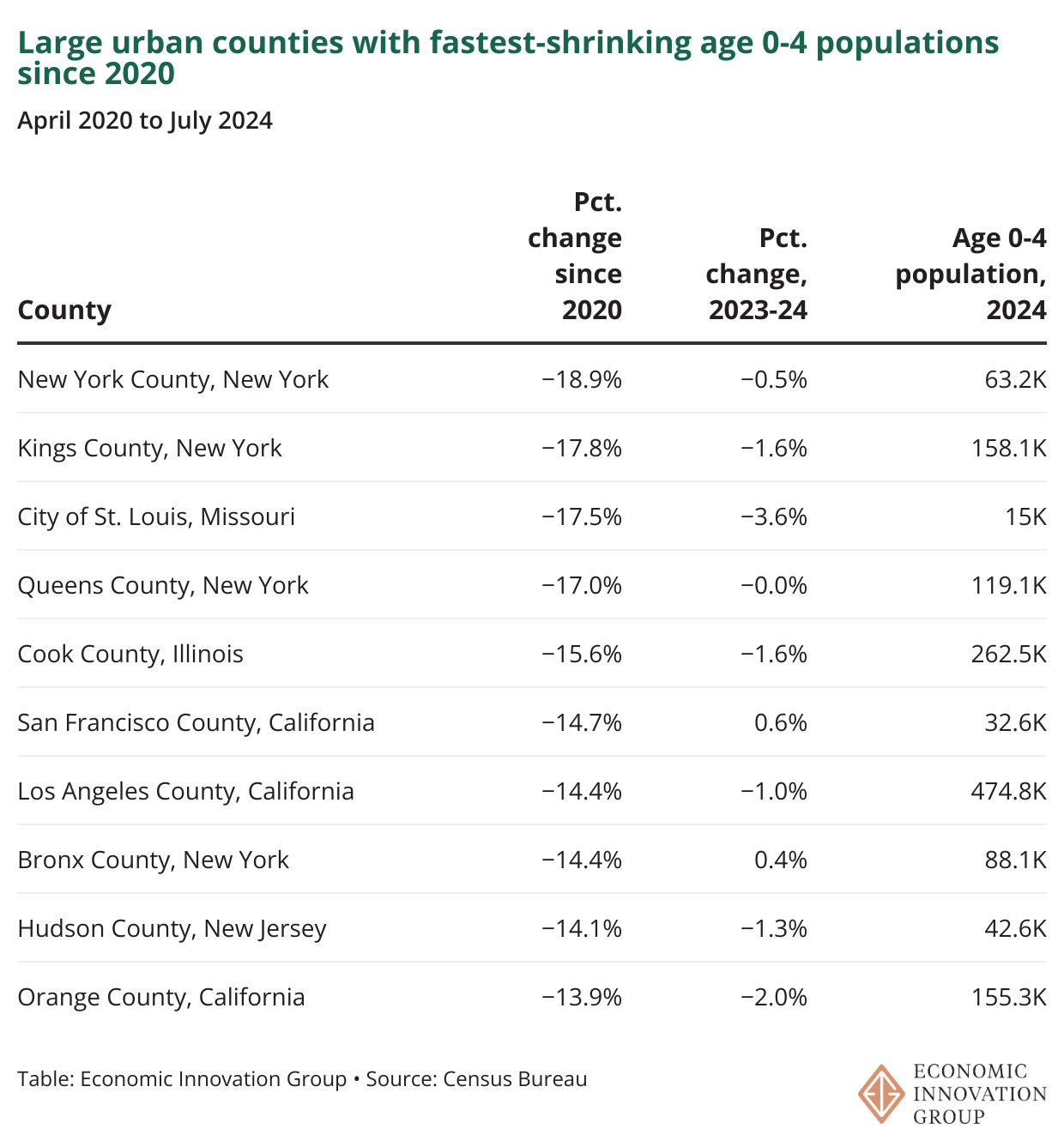Young families have stopped leaving big cities, for now
But flatlining growth has not reversed massive pandemic-era population losses.
The steep and startling decline in the number of young children living in America’s major cities was a defining demographic story of the Covid-19 pandemic and its aftermath. New data suggests that this “urban family exodus” has stopped, at least for the moment.
The population of children under five years old declined a modest 0.2 percent in the country’s large urban counties between July 2023 and July 2024, the same rate of decline as for the country as a whole. Last year was the first since the pandemic in which the under-five population did not decline faster in the county’s largest cities than it did nationwide.
Many big cities stopped losing young families in 2024.
Last year we highlighted New York City, one of the cities with the sharpest declines in the population of young children during the pandemic. After falling eight percent in 2021, five percent in 2022, and a further 2.5 percent in 2023, New York City’s population of kids under five remained relatively stable in 2024, falling by just 0.5 percent.
The Bronx experienced positive growth in this population for the first time this decade, the only borough since the pandemic to have had even a single year of positive growth.
The decline in young kids has also slowed or outright stopped in other major cities.
The population of kids under five years old in San Francisco even grew slightly (0.6 percent) last year, though it remains 15 percent smaller than it was in April 2020.
Large urban counties like Los Angeles County (-1.0 percent in 2024), New Orleans (0.9 percent), and Philadelphia (flat), which experienced very large declines in their under-five populations in prior years, also improved in 2024 relative to their post-pandemic trends.
Suffolk County, Massachusetts, which includes the City of Boston, had perhaps the most surprising reversal last year. Its population of kids under five years old jumped 2.5 percent in 2024, a far higher growth rate than any other large urban county in the Northeast.
Major cities still have many fewer young kids than in 2020.
Still, none of the large urban counties whose under-five populations declined the most between 2020 and 2023 are anywhere close to recovering to pre-pandemic levels.
Among 83 large urban counties, Manhattan (New York County) had the steepest decline in young kids since April 2020, 18.9 percent. Brooklyn is right behind, with a 17.8 percent decline.
The City of St. Louis (-17.5 percent), Cook County, Illinois (-15.6 percent), San Francisco County (-14.7 percent), and Los Angeles County (-14.4 percent) are also well below April 2020 under-five population levels.
There are, however, some family-friendly bright spots worth highlighting, especially across the Sun Belt. In fact, every large urban county that has grown its under-five population since 2020 is in Texas, North Carolina, or Florida.
Collin County, Texas, which contains Plano and a small slice of Dallas, now has 13 percent more young kids than it did in April 2020.
Lubbock County, Texas (+5.6 percent) and three North Carolina counties — Mecklenburg (+5.5 percent), Wake (+3.2 percent), and Forsyth (+2.8 percent) — have also grown significantly over this period.
Rural counties and small towns are now losing young families faster than cities.
During the pandemic and its initial aftermath, declines in young children living in urban counties were much larger than in other types of counties. That pattern no longer holds.
In 2024, small towns and rural counties experienced larger declines in their populations of young children than small, mid-sized, and large urban counties. Meanwhile, suburbs’ under-five population grew very slightly, as it also did in 2022 and 2023.
The lesson for big city mayors: don't neglect the fundamentals.
Big cities’ dire demographic trends post-pandemic raised deep questions about just how family-friendly major American cities are today. Theories of what drove the urban family exodus are varied, including lockdowns, public safety, spiraling housing costs, and new opportunities offered by remote work. Each almost certainly contributed, even if the factors that mattered most are difficult to identify with precision.
But at their core, none of the factors that pushed thousands of families out of big cities over the last few years are new. The basics of urban governance — providing safe streets, quality schools, functional housing markets, and reliable transit — still matter. They are particularly important to families with kids.
If big city mayors and leaders neglect these fundamentals, there is no reason the urban family exodus cannot resume.
The Github repository for this analysis is available here.
Appendix
County definitions are constructed using NCES classification system for locales, adapted to counties. County residents are identified as living in an NCES locale based on block groups. E.g., if 50% of the population is in a block group that is located inside a Rural locale, then 50% of the county is considered to be within a rural area. For block groups that cross locale boundaries, the population is split equally between those locales. A county is classified as large urban, mid-sized urban, small urban, suburban, small town, or rural, based on the criteria below. The full methodology and replication files for this classification system are available here.









